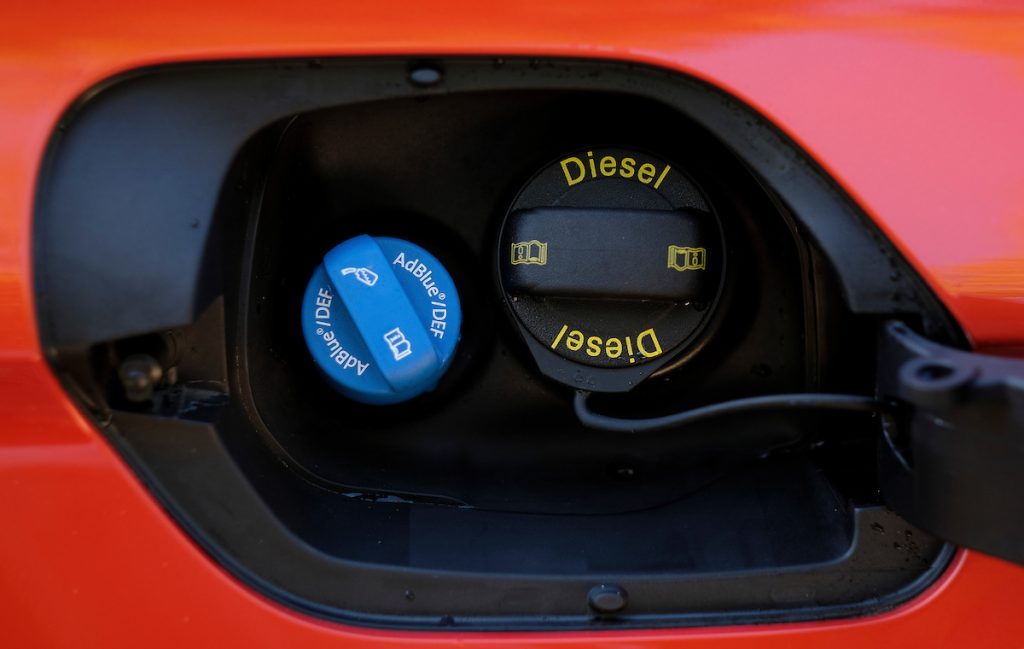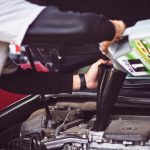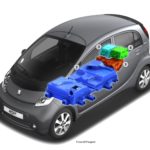AdBlue is designed to reduce harmful exhaust emissions from diesel engines. If your car runs out of it, the engine won’t start. Here we answer how you fill your car with AdBlue and how often, can you refill it yourself (it’s often very simple), what happens if you run out of it and can you drive if there is none.
How do I fill AdBlue?
The AdBlue refill container comes with a special spout that plugs into the car’s filler cap. This enables you to top it up without wasting any of the liquid. You simply pour it in. The car’s computer should tell you how much you need to fully replenish the tank.
Although it’s a non-toxic liquid, AdBlue is an irritant. If you get it on your skin, you should wash it off immediately. It’s the same story with paintwork: the solution is corrosive and can damage it.
How do I know when the AdBlue tank is full?
Rather like when you’re filling up the fuel tank, there’s no easy way to see when the AdBlue is nearly full. You can overfill your car but there’s no need to. If you pay attention, the noise of pouring it in will change slightly and you’ll see the liquid in the filler spout.
How often do you need to refill AdBlue?
Although AdBlue isn’t a fuel additive, the harder you drive and the more fuel you use, the more the system injects.
Fuel giant Total says cars use 1 litre of AdBlue for anywhere between 350 and 600 miles. But how efficient the system is and therefore how much your car will use depends on the engine capacity and the car’s age.
AdBlue consumption is usually from 3 to 6% of the amount of diesel your car consumes.
If your car does 50mpg, it’s using 4.55 litres of fuel every 50 miles. If it’s drinking AdBlue at a rate of 3% of fuel consumption, that’s just 0.14 litres every 50 miles.
Manufacturer GreenChem estimates cars such as a Vauxhall Insignia will use 1 litre every 620 miles.
A heavier SUV or MPV such as a Vauxhall Zafira will drink 1.5 litres every 620 miles. A fill up should last from one service to the next. Total says that the range of cars after they’ve been filled up falls anywhere between 3,000 and 12,000 miles.
How long can I drive with the DPF light on?
Can I refill it myself?
That depends on the car. First, consult the user manual. With some models, there’s a second blue filler cap, usually next to the main black fuel cap. Or it might be in the boot. If either of those is the case, you can top up the AdBlue yourself.
But on some cars, the tank is hidden beneath the car. You need to take it to a garage to have the tank refilled.
How much AdBlue do I need?
Most AdBlue comes in 10-litre containers. But you can buy 5 litres or 20 litres. It costs anywhere between £10 and £20 per 10-litre container. You can buy it over the internet (usually the cheapest option), from motor retailers and from most service stations.

What happens if I run out of it?
Your car should have an electronic indicator plus amber warning light on the dashboard to tell you how much AdBlue you have or haven’t got. This will warn you when AdBlue range falls to around 1,500 miles, giving you plenty of time to fill it up.
Can I drive if AdBlue is empty?
If you ignore these warnings, the car won’t simply stop but engine performance may be limited. This is because the engine will reduce its output to reduce its emissions because the AdBlue can no longer do that job. If you turn the engine off, it may not start again until you’ve topped up the AdBlue.
What if you put AdBlue in the wrong tank
Whether you put AdBlue in your diesel tank or diesel in the AdBlue tank, don’t start the engine. Mixing AdBlue with diesel could damage the engine’s delicate internals. A drop of diesel in the exhaust system could affect the Selective Catalytic Reduction process. If either happens, seek professional advice.
What is AdBlue made of?
AdBlue is a colourless liquid that ever-more diesel cars use to reduce poisonous exhaust emissions. It consists of approximately two thirds demineralized water, one third automotive urea.
What does it do to your car?
Ever more stringent emissions regulations mean manufacturers have had to investigate different ways to reduce the harmful gases their cars produce. To comply with the latest Euro 6 and Euro 7 standards which demand diesel cars limit the amount of nitrogen oxides (NOx) they produce, car makers employ what’s called Selective Catalytic Reduction (SCR).
The system injects a tiny amount of urea into a diesel car’s exhaust fumes. This transforms the harmful NOx gases into harmless nitrogen and oxygen. The technology is well proven and has been used in lorries and coaches for around a decade.
How do you know if your car has it?
First port of call should be the user manual to see if the car has SCR. Otherwise, you may have noticed a blue fuel filler cap somewhere towards the back of the car, probably next to the diesel filler cap.

I’ve been writing about cars and motoring for more than 25 years. My career started on a long-departed classic car weekly magazine called AutoClassic. I’ve since pitched up at Autosport, Auto Express, the News of the World, Sunday Times and most recently the Daily Telegraph. When I’m not writing about cars and motoring, I’m probably doing some kind of sport or working in my garden.







